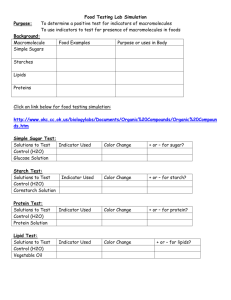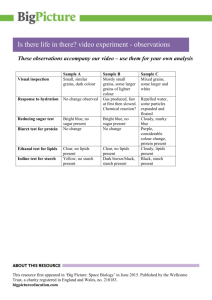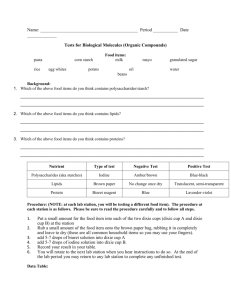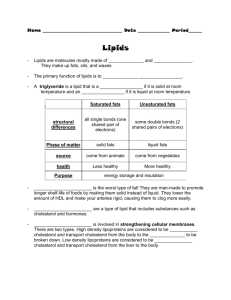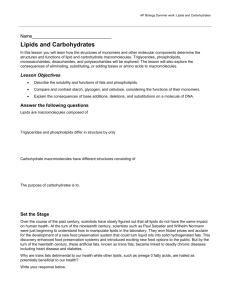Macromolecules in my food!!
advertisement
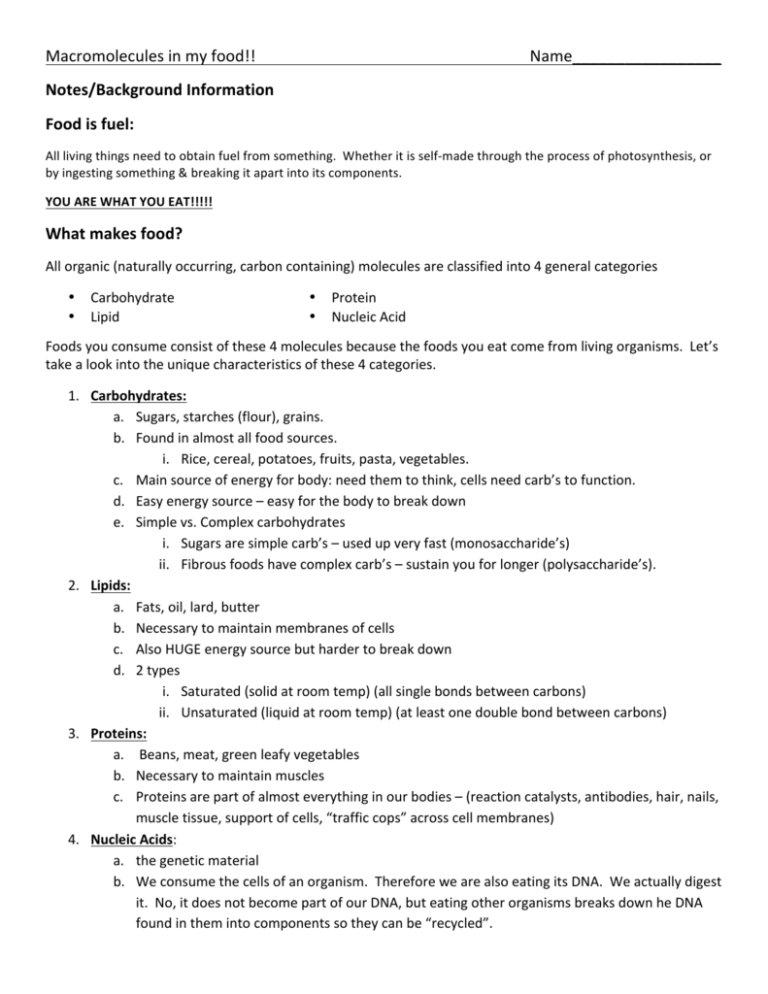
Macromolecules in my food!! Name_________________ Notes/Background Information Food is fuel: All living things need to obtain fuel from something. Whether it is self-­‐made through the process of photosynthesis, or by ingesting something & breaking it apart into its components. YOU ARE WHAT YOU EAT!!!!! What makes food? All organic (naturally occurring, carbon containing) molecules are classified into 4 general categories • • Carbohydrate Lipid • • Protein Nucleic Acid Foods you consume consist of these 4 molecules because the foods you eat come from living organisms. Let’s take a look into the unique characteristics of these 4 categories. 1. Carbohydrates: a. Sugars, starches (flour), grains. b. Found in almost all food sources. i. Rice, cereal, potatoes, fruits, pasta, vegetables. c. Main source of energy for body: need them to think, cells need carb’s to function. d. Easy energy source – easy for the body to break down e. Simple vs. Complex carbohydrates i. Sugars are simple carb’s – used up very fast (monosaccharide’s) ii. Fibrous foods have complex carb’s – sustain you for longer (polysaccharide’s). 2. Lipids: a. Fats, oil, lard, butter b. Necessary to maintain membranes of cells c. Also HUGE energy source but harder to break down d. 2 types i. Saturated (solid at room temp) (all single bonds between carbons) ii. Unsaturated (liquid at room temp) (at least one double bond between carbons) 3. Proteins: a. Beans, meat, green leafy vegetables b. Necessary to maintain muscles c. Proteins are part of almost everything in our bodies – (reaction catalysts, antibodies, hair, nails, muscle tissue, support of cells, “traffic cops” across cell membranes) 4. Nucleic Acids: a. the genetic material b. We consume the cells of an organism. Therefore we are also eating its DNA. We actually digest it. No, it does not become part of our DNA, but eating other organisms breaks down he DNA found in them into components so they can be “recycled”. Testing for Macromolecules This is the same test you will perform for the ingredients in your salad dressing. Materials: Test tube Spot Plate Biuret Test tube rack (&holder) Hot water bath Benedict’s Solution Toothpicks Brown Paper Bag Iodine Substances to be tested provided by Mrs. Whitacre (Vegetable oil, Corn starch, Red wine Vinegar, Sugar, butter, Potato chips) If you brought in your own food substances to be tested from home you may – It is required that you test at least 8 food samples!! □ Before beginning lab…read the instructions for testing each macromolecule & then complete the pre lab table indicating what you will see for a positive test for each biomolecule. □ Then fill out the “Predictions” column in the data table below – which macromolecule (s) do you think each substance will have? □ These will be completed for HW Thursday 11.1 night. Part A: Testing for Carbohydrates: Monosaccharaides/Simple Sugars Glucose, commonly called “blood sugar,” and fructose, “fruit sugar,” are two of the most common monosaccharaides. Monosaccharide’s can be identified in a substance using an indicator called Benedict’s solution. When Benedict’s is heated in the presence of a monosaccharide, the color changes from blue to green to yellow to reddish-­‐orange, depending on the amount of monosaccharide present. Procedure: 1. Mrs. Whitacre will have a hot water bath already prepared for you to use. 2. While this is heating, add 2 dropper-­‐full of each sample to a test tube. Add 10 drops of Benedict’s solution to each test tube. Be aware of which sample is which (label) 3. Place the test tubes in the hot-­‐water bath. Heat the test tubes until the indicator changes color OR for 1 minute max if it doesn't seem to be changing color. 4. With a test tube holder, remove the tubes from the hot-­‐water bath and place them back in the test tube rack. 5. Record any changes in your data table. Part B: Testing for Carbohydrates: Polysaccharides/Starch Monosaccharide’s may join together to form long chains called polysaccharides that may be either straight or branched. Starch is an example of a polysaccharide formed entirely of glucose monosaccharide’s. Polysaccharides can be tested for using the indicator Lugol’s reagent (iodine/potassium iodine). Lugol’s will change color from yellow-­‐brown to blue-­‐black-­‐purple in the presence of starch. Procedure: 1. Add a few drops of each sample to a spot plate. (be sure to be aware of which sample is which!) 2. Add 1 drop of Lugol’s to each sample. 3. Record any changes in your data table. Part C: Testing for Lipids Lipids can be generally categorized into two subgroups: saturated fats and unsaturated fats. In saturated fats, the carbon chains are bonded together with only single covalent bonds and the remaining electrons are bonded to hydrogen. This structure keeps the hydrocarbon tails relatively straight, so they readily align with each other, pack closely together, and thus tend to be solid at room temperature. Saturated fats are most common in animals. Unsaturated fats have double bonds between the carbons and therefore do not have the maximum number of links to hydrogen. These regions of double bonding allow kinks to form in the hydrocarbon tails, keeping them from packing closely together. For this reason, unsaturated fats are usually liquid at room temperature. Unsaturated fats are common in plants. Lipids can also be tested for using the “sack lunch” method: the lipid is rubbed into a brown bag. If a grease spot appears (the brown bag appears translucent), then a lipid is present in the food. Procedure: Grease spot test (sack lunch): 1. Cut a piece of a paper lunch sack and make a grid (using a pencil, not a pen) for all the food samples you will test. Label each square with a different food sample. 2. Add 4-­‐5 drops each solution to the appropriate square on the lunch bag. If solid, rub solution on paper bag. 3. Rub the solution until a “wet” spot appears on the paper. Wait for the foods to evaporate. 4. Hold the brown paper up to a bright light. Check for grease spots 5. If the paper has grease spots – then the sample has lipids. 6. If found to have lipids, determine if your sample is a SAURATED or UNSATURATED far (how would you know this?) Part D: Testing for Proteins Proteins are made up of one or more polypeptides, which are linear polymers of monomers called amino acids. Amino acids derive their name from the amino group and the carboxyl group (which is acidic). Polypeptides are formed when amino acids are joined together by peptide bonds between the amino group of one amino acid and the carboxyl group of another amino acid. Proteins can be tested for using Biuret’s reagent, which reacts with the peptide bond between amino acids in the polypeptide. Biuret’s reagent turns from blue to purple-­‐violet if peptides bonds are present. Procedure: 1. Add a few drops of each sample to a spot plate. (be sure to be aware of which sample is which!) 2. Add 3-­‐5 drops of Biuret’s reagent to each sample. 3. Record any changes in color. Part E: “Testing” For Nucleic Acids If the ingredient came from a living organism or was at one point living, then it contains a nucleic acid. There is no specific test for this – you just need to use analytical reasoning. Name_________________________________ Each person in group will complete this lab. Keep the above portion as notes & turn in ONLY this page. PRE LAB QUESTIONS Data table What are the four major groups of macromolecules? What does each do for the cell or organism asa a whole? Provide an example of them in food as mentioned above. Macromolecule Group *********** Role in the cell or organism Examples of them in food Once you have read the instructions above, fill in the data table about the lab analysis. Macromolecule type Monosaccharide (sugar) Polysaccharide (starch) Lipid Protein Nucleic Acid What do you use to test (***TURN OVER FOR MORE QUESTIONS) What will you see if positive Predictions of Food Samples Food Sample (those required for the lab) Vegetable Oil Corn Starch Red Wine Venegar Potato Chip Sugar Butter Salad Dressing Ingredients: Enter below & make a prediction Prediction of Macromolecules Present Observations (Keep this as proof to use in your product report (lab analysis portion)) Fill out the table below based on the observations in which you see for each substance tested. If a food sample tests positive for the test enter +. If it tests negative enter -­‐. Food Sample Result from benedicts test (test sugars) Result from biurets test (test proteins) Result from Result from lugol’s test grease spot (test starch) test (test lipids) Vegetable Oil Corn Starch Red Wine Vinegar Potato Chip Butter Sugar YOUR SALAD DRESSING INGREDIENTS BELOW Macromolecules present in sample Result from nucleic acids “test”



